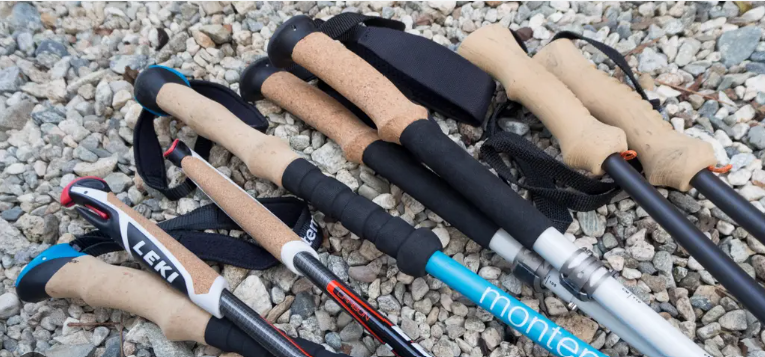
Top 5 Reasons to Use Hiking Poles: Unleashing the Power of Trekking Gear
Share
Are you ready to take your hiking experience to new heights? If you're an outdoor enthusiast seeking an edge in your treks, look no further than hiking poles. These versatile tools have become increasingly popular among hikers of all levels, transforming the way we navigate through challenging terrains. In this article, we'll delve into the top 5 reasons to use hiking poles, outlining the advantages they offer for your next adventure.
Top 5 Reasons to Use Hiking Poles
Hiking poles have gained recognition as indispensable accessories that can significantly enhance your trekking endeavors. Let's explore the top 5 reasons why these sturdy companions should be a part of your hiking gear arsenal.
1. Improved Stability and Balance
Maintaining balance while traversing rugged trails is crucial to avoid potential falls and injuries. Hiking poles act as additional points of contact with the ground, providing a wider base of support. By planting the poles firmly and rhythmically, you'll experience improved stability on various terrains, including steep ascents, uneven surfaces, and slippery descents. With enhanced balance, you'll be able to tackle challenging sections of the trail with greater confidence and peace of mind.
2. Reduced Joint Strain and Impact
Long hikes can take a toll on your joints, particularly knees and ankles. Hiking poles serve as shock absorbers, helping to alleviate the strain on these vulnerable areas. With each step, the poles distribute the impact of your body weight, reducing the stress on your lower extremities. This effect is particularly beneficial when navigating downhill sections, as the poles absorb the shock that would otherwise be absorbed by your joints. By using hiking poles, you can minimize discomfort and potential long-term joint issues, allowing you to enjoy your outdoor pursuits for years to come.
3. Increased Endurance and Energy Conservation
It's no secret that hiking can be physically demanding, especially during long treks or when carrying a heavy backpack. Hiking poles effectively engage your upper body muscles, specifically the arms, shoulders, and core. By utilizing these muscle groups in tandem with your legs, you distribute the effort more evenly, reducing the strain on your lower body. This efficient energy transfer can help you conserve stamina, enabling you to trek for longer durations and conquer more challenging trails.
4. Enhanced Posture and Back Support
Maintaining good posture is vital for both comfort and overall well-being while hiking. Hiking poles encourage an upright posture, preventing excessive forward bending and promoting proper spinal alignment. By engaging the muscles of your back and core, hiking poles provide additional support, reducing strain on your lower back. This improved posture not only enhances your overall hiking experience but also minimizes the risk of backaches or injuries caused by poor alignment.
5. Versatility in Various Terrains and Conditions
Whether you're trekking through a dense forest, conquering a rocky mountain trail, or crossing a snow-covered landscape, hiking poles offer versatility to adapt to various terrains and weather conditions. With adjustable length settings, you can customize your poles to suit different inclines and ensure optimal comfort. Additionally, hiking poles equipped with interchangeable baskets can be easily adapted for snow, mud, or loose gravel. This adaptability empowers you to tackle a wide range of outdoor environments while maintaining
FAQs about Hiking Poles
Curious hikers often have questions about incorporating hiking poles into their outdoor excursions. Here are answers to some frequently asked questions to shed light on their usage and benefits:
Q1: Do I need hiking poles if I'm an experienced hiker?
Experienced hikers can benefit greatly from using hiking poles. These tools offer improved stability, reduce joint strain, and enhance endurance, regardless of your level of experience.
Q2: How do I adjust the length of my hiking poles?
Most hiking poles come with adjustable length settings. To find the right length, stand with your elbow at a 90-degree angle while gripping the pole handle. Adjust the length until your forearm is parallel to the ground. Ensure that the adjustment mechanism is secure before embarking on your hike.
Q3: Can hiking poles be used on steep descents?
Absolutely! Hiking poles are particularly useful on steep descents. By planting the poles in front of you as you descend, you create additional points of contact, providing stability and reducing the impact on your knees and ankles.
Q4: Can hiking poles be used on flat terrain?
While hiking poles are commonly associated with challenging terrains, they can also be beneficial on flat terrain. They help with balance, provide upper body engagement, and offer an additional source of support during long walks.
Q5: Are hiking poles suitable for all ages?
Hiking poles are suitable for hikers of all ages. They provide stability, reduce joint strain, and enhance overall hiking experience, making them valuable tools for both young and seasoned adventurers.
Q6: Can hiking poles be used in winter or snowy conditions?
Yes, hiking poles can be used in winter or snowy conditions. Look for poles with snow baskets, which can be easily attached to prevent the poles from sinking too deeply into the snow, providing added stability on slippery surfaces.
Conclusion: Unleash the Power of Hiking Poles for Unforgettable Adventures
As you embark on your next hiking expedition, consider the tremendous benefits that hiking poles can bring to your outdoor experience. From improved stability and reduced joint strain to increased endurance and versatility, these invaluable tools have revolutionized the way hikers navigate challenging terrains. So, don't hesitate to grab a pair of hiking poles and unlock their full potential. With the top 5 reasons to use hiking poles in mind, you'll be well-equipped to conquer any trail that lies ahead.
